REMEMBERING SABAPATHY ALAGIAH

20 September 1938 – 30 August 2009
Here is a brief story of Sabapathy Alagiah, who allowed himself to be carried as a leaf in the wind from the day he accepted the Faith. Sabapathy, lovingly known as Saba to friends constantly served the Faith with unflinching vigor. He underwent untold sufferings and trials throughout his pioneering days, and yet soldiered on relentlessly, all because of the unshakable love he had for Bahá’u’lláh. History would portray Saba as a rare kind of pioneer.
Saba labored for the growth of the Cause within Malaysia during the early 1960s, and became one of the most distinguished and illustrious servants of the Cause of Bahá’u’lláh. His exemplary spirit shall always be fondly remembered.
Saba, the eldest among nine siblings comes from a family of strict Hindu tradition. His father, Mr. Alagiah Murugan was very much involved with the Hindu Association that propagated Hinduism in the town of Seremban in the state of Negeri Sembilan, Malaysia. His mother Mrs. Selvajothy Alagiah was also an ardent follower of Hinduism. This family was very well known in the circle of friends in the Hindu temples and Tamil schools in Negeri Sembilan for their strong attachment to both the Hindu religion and Indian traditions. Going to the temples every Friday and attending Hindu religious classes at the Swami Vivekananda Hall each Saturday became part of their life.
The Bahá’í Faith came to Saba in 1960. Saba was a schoolmate and very close friend of S. Satanam in the Anglo-Chinese School in Seremban. They were teammates on the school hockey and football teams. Satanam accepted the Faith in 1960 and through him some 10 of his classmates accepted the Faith, including Saba. Soon a set of 16 vibrant youths emerged in Seremban, including Jack Tan, Alan Tan, Isaac DeCruz, Pauline DeCruz, Nit Singam, K. Krishnan (Postman Krishnan) and Annamalai. With these youths the Seremban Bahá’í Youth Section was formed in the same year with Satanam as Chairman and Saba, its Secretary. In 1961 the town of Seremban had one of the most active youth committees in Malaya.
From the day Saba accepted the Faith, he was actively involved in Bahá’í activities and spent his time in the company of youths in the rented Bahá’í Centre in Birch Road. Saba’s active involvement in the Faith became noticed and reported to his parents. When Saba’s Hindu parents heard that he had accepted the Bahá’í Faith, they expressed their strong dissatisfaction on his departure from established traditions in the family. Saba was sad and started to pray for Bahá’u’lláh to open the eyes of his parents. Although his parents were against Saba attending the Bahá’í activities, they did not bar his friends from coming to their home to visit Saba. Each time the Bahá’ís visited Saba in his house, they recited Bahá’í prayers, often in the company of his parents. One listening to the prayers his parents were slowly convinced that their son was moving with prayerful people representing some good cause. These prayer sessions won over the hearts of his parents, who gladly gave him full permission to go for Bahá’í activities. Saba was on cloud nine and started take his younger brothers Ratnam (the late Dr. Ratnam Alagiah who passed away in Canada on 21 January 2013) and Sethupathi and his sister Leela to the Bahá’í Centre which was by then the house of Yankee Leong in Rahang to attend children’s classes and Bahá’í meetings attended by children from the Chinese, Indian, Orissa and Asli backgrounds. In these classes, they learnt about the Bahá’í Faith. Ratnam, Sethupathi and his sister Leela later accepted the Faith.
Saba began his career as a Technician in the Telecommunications Department in Seremban. He then attended courses and later became a Telecommunications Technician. As a full-fledged Telecommunications Technician, Saba was well respected by his colleagues, subordinates, and superiors in his work place, who came to know that Saba practiced the Bahá’í Faith.
With the full found freedom that his parents provided Saba spent much of his time in the Seremban Bahá’í Centre, with a keen zeal to do something for the Faith. Saba was one of the active youths of Seremban, involving in all kinds of local and regional activities. That was a time when the Faith needed much manpower to take the Faith to various parts of Negeri Sembilan state. Saba joined the teaching teams that went daily to the rubber plantations in the state of Negeri Sembilan. S. Satanam was one of his constant companions in the teaching field. All these teaching trips were carried out each day in the evenings after office hours, and throughout the days on weekends. At that time no believer had any car. There was one Major Harry C. Charles who worked with the British troops in Seremban in the early 1960s. He accepted the Faith in 1961 and, before leaving the country, donated his car for the Seremban believers. This car was used for some time before it was sold off and the proceeds given to the funds. Occasionally Saba’s father used to let him use the family car to take the friends teaching. Yet public transportation was the chief means of reaching the people.
For Saba, field teaching was the favorite area of service. He was an exemplary teacher in many ways. He was always patient with his enquirers and answered all their questions after giving a listening ear. Patience, utter humility, and simplicity were his virtues that Saba cultivated as a believer and these very virtues attracted many to him, and through him to the Cause. Apart from teaching in the rubber plantations, he had also undertaken a few teaching trips to the aboriginal villages in the deep jungles of Malaya. He showered sincere love to those aborigines that the old timers still remember him to this day.
In 1962 Saba was elected on the Local Spiritual Assembly of Seremban and served as its secretary. As an effective secretary, he sent out a constant flow of letters to individuals in Seremban and other Local Spiritual Assemblies providing them with the latest update of events taking place at the Bahá’í Centre in Seremban.
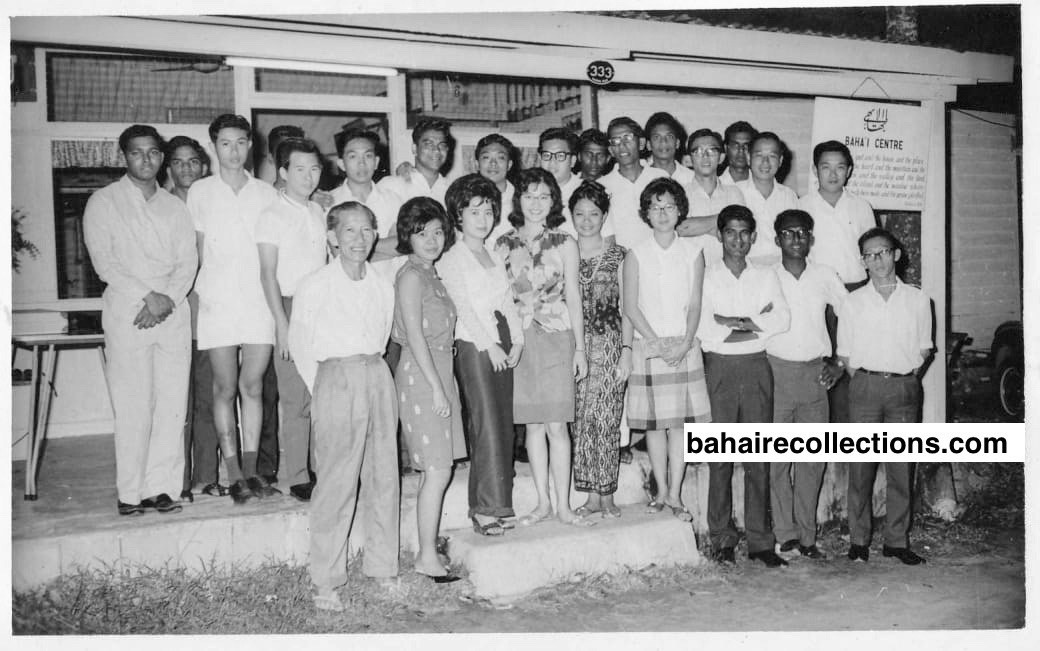
Saba at extreme left with his peers at Seremban Bahá’í Centre, 1962. Yankee Leong is at the extreme left in front row. Second from right is R. Mariappan, and third from right is Isaac DCruz.
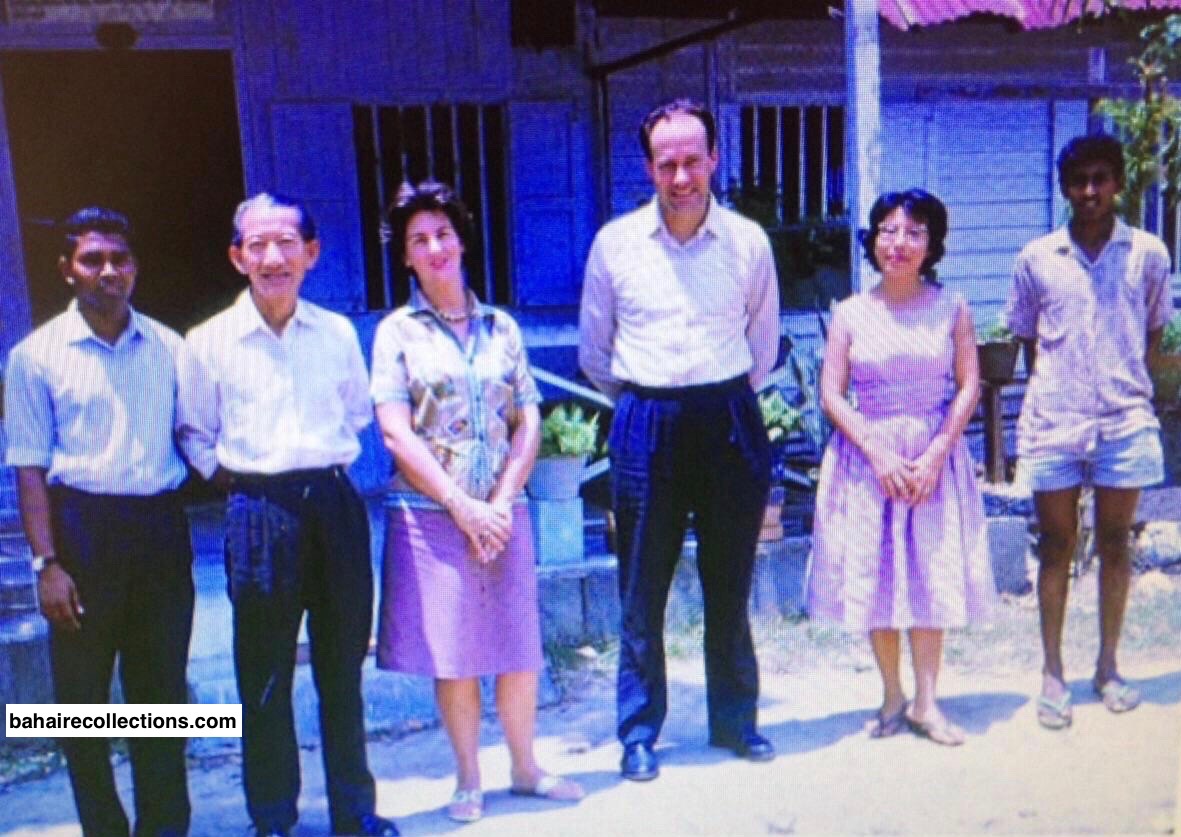
Seremban Bahá’í Centre, 1963. Saba, Yankee Leong, Margaret Bluett, Noel Buett, Lily Ng, (unknown). Margaret and Neol visited Seremban on their way to the First Bahá’í World Congress. (Photo credit: Margaret Bluett)
Saba’s knowledge in the Cause came from the Holy Writings, while his strongest inspiration came from the Hand of the Cause of God Dr. Muhajir. Saba’s love and respect for Dr. Muhajir were so profound that he obeyed him without any question whatsoever. On several occasions, Saba himself had undertaken teaching trips with Dr. Muhajir. In 1962 Saba joined Satanam and K. Krishnan in traveling in a car for a teaching trip to Teluk Anson (Teluk Intan today) in the company of Dr. Muhajir. Saba always used to mention that going for teaching in the company of Dr. Muhajir was an experience where he had learnt so many lessons. The advice and guidance that Dr. Muhajir gave, the concise answers he provided for his questions as a new believer – all these added up to his firmness in the Faith. It was on the encouragement of Dr. Muhajir that Saba and other Bahá’ís undertook teaching trips to the East Coast states in the early 1960s, at a time when that area was not opened up for the Cause. Heeding to Dr. Muhajir’s call to develop the East Coast, in March 1963, S. Satanam, Alan Tan and Saba undertook a two-week teaching trip to Pahang state. As a follow-up, Saba had also teamed up with Satanam to travel on a motorcycle to the East Coast and on a few occasions escaped death on those rough roads.
It was on the request of Dr. Muhajir that in later part of 1962, Saba went as a homefront pioneer to another town called Kuala Pilah. It was through a dramatic event that he left for Kuala Pilah. In one of his trips to Seremban in 1962, Dr. Muhajir saw that Seremban had a good number of believers and he felt some should relocate themselves elsewhere to spread the Cause. Dr. Muhajir spoke to the Bahá’ís of Seremban to go home front pioneering to other areas in Malaya. Saba and Satanam were present in this gathering. Some of the Bahá’ís responded saying, “We have families to look after.” Dr. Muhajir smilingly but quite seriously asked, “How if you die tomorrow?” This statement of urgency opened the eyes of those who heard him. Satanam and Saba who felt the urgency from the tone of Dr. Muhajir ’s response requested for a transfer out of Seremban. That was how Satanam went off to Jelebu in 1961 and Saba went off to Kuala Pilah in 1962 as home front pioneers. While they were away from Seremban they still continued to give assistance to Seremban or join in their activities. Transferring out of Seremban to Kuala Pilah was the first move for Saba, not realizing that he had in store a final destiny out of the country, and far away in a remote corner of the globe.
During Saba’s stay in Kuala Pilah from 1962 to 1967, remarkable achievements and victories were brought for the Cause, with a surge in Bahá’í activities resulting in large scale enrollments. At the time when Saba came to Kuala Pilah, the town was given a “Group” status for the period 1962 to 1963, according to the Bahá’í World (1954-1963). Saba brought some of his colleagues in the government service in Kuala Pilah into the Faith. Several other strong believers both in Kuala Pilah and in the neighboring town of Bahau soon joined Saba in spreading the Cause. Chief among them were Jami Subramaniam in Rompin town, Rama Naidu a teacher who moved into Bahau from Gemas town, G. Appala Naidu (G.A. Naidu) a teacher in Bahau, and N. Nagendran who came to report as a government servant in Kuala Pilah. They formed a harmonious teaching team in taking the Cause to the surrounding areas. These Bahá’ís brought in hundreds of people into the Faith. By mid-1960s the little hill town of Kuala Pilah had a substantial number of Bahá’ís. The Faith was also taken to all the neighboring estates surrounding Kuala Pilah. They organized the visit by Mr. Hushmand Fatheazam, member of the Supreme Body to Glendale Estate in August 1965 on the occasion of his visit to Malaysia. More than 200 friends from the town and the surrounding areas joined in the celebrations of Naw-Rúz in Kuala Pilah in 1966. Kuala Pilah was named as one of the earliest communities to have celebrated Naw-Rúz on a grand and befitting scale. Thus the mid-1960s became a period of dynamism in Kuala Pilah area.
The Malaysian Bahá’í News magazine was published with its base in Penang, having regional correspondents in several parts of the country. Saba was the regional correspondent for the Kuala Pilah area and sent several news of interest to the magazine.
OFF TO PIONEER
Meanwhile, Dr. Muhajir was actively monitoring the development of the Faith in South East Asia, and saw the need for manpower in some countries. Dr. Muhajir had always seen the potential of the Malaysian Bahá’ís. In 1967 when he decided to send a group of pioneers out of Malaysia, Saba who was serving as Chairman of the National Teaching Committee of Malaysia was identified as one of them. During a visit by Dr. Muhajir to Malaysia on Naw-Rúz day in 1967, he encouraged Saba to pioneer to Indo-China, specifically to Laos where manpower was needed in abundance. Saba instantly obeyed the revered Hand of the Cause and resigned as Technician in the Telecommunications Department. By tendering the resignation letter, Saba was acutely aware that there would be no pension to keep his life going at his last days. In those days securing a government job was seen as most prestigious. He received instant and abundant criticism from his colleagues for the most shocking decision he had made. But Saba felt he was right on all counts, and knew what he was doing when he made up his mind. When leaving the shores of Malaysia for Thailand in 1967, he had told his close friend Satanam, “I am starting a journey of no return, and I desire to have my bones buried in the country where I pioneer.”
Saba then said good bye to his family and friends and left for the Summer School held in Songkhla, South Thailand in mid-August of 1967. Saba’s original intention was to pioneer to Laos. But fate changed when Saba attended that Summer School. Some members of the National Spiritual Assembly of Thailand and Firaydun Mithaq who was a Counselor and pioneer to Laos held a consultation and observed that Thailand had urgent needs of pioneers. After consulting with other members of the national institution of Malaysia who were also attending the Summer School, it was decided that Saba should remain in South Thailand. With that Saba became the first Malaysian pioneer to Thailand. At the Summer School itself, a tribute was paid for Saba for the example he had set. In South Thailand, Saba was employed in the Klubpet Suksa High School for a few months, where the principal and a few teachers were Bahá’ís. He helped elect the Local Spiritual Assembly in Songkhla. With the flow of other Bahá’í visitors from Malaysia, he was assigned to help strengthen the Faith in South Thailand.
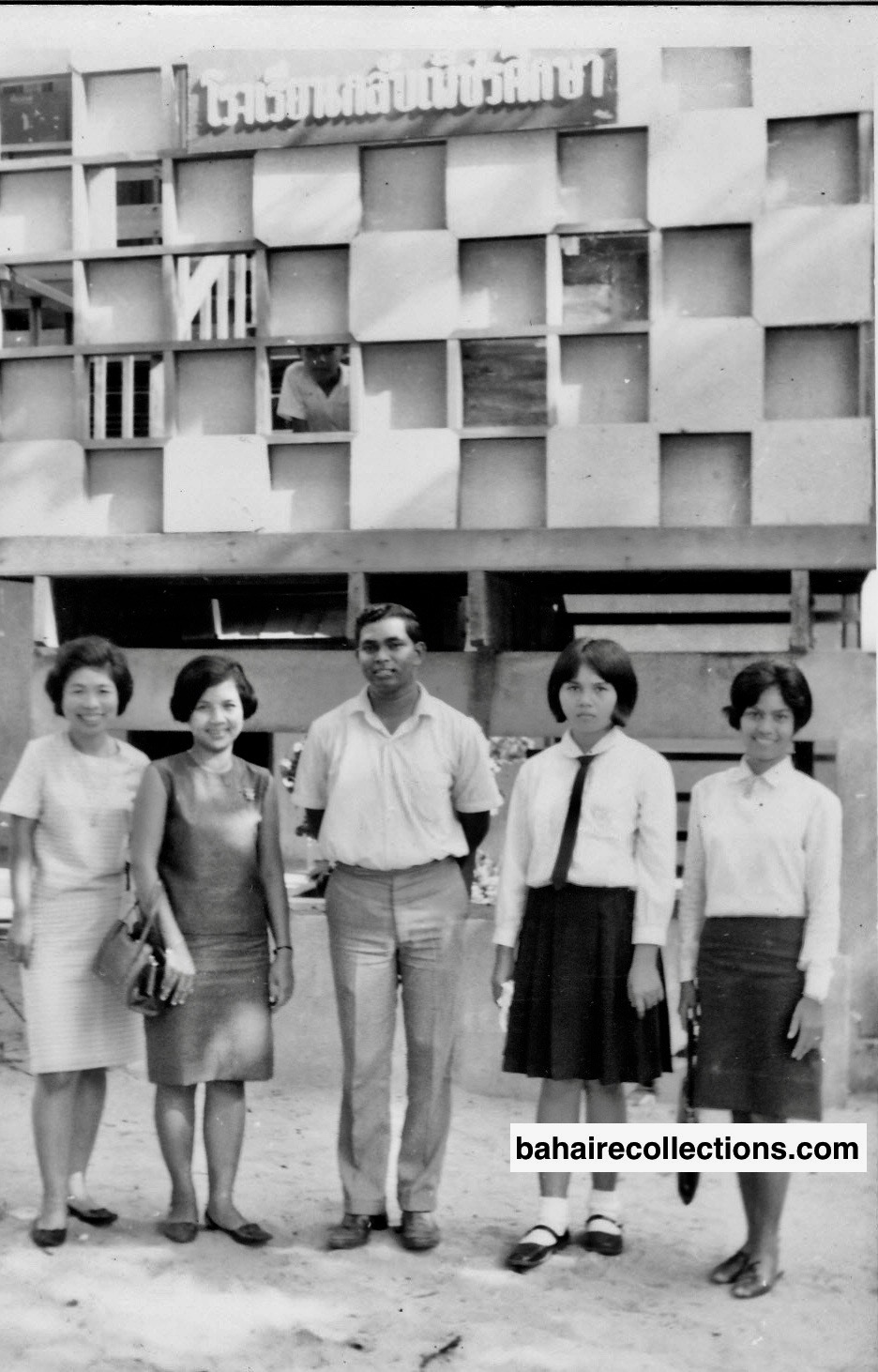
At Klubpet Suksa High School, Thailand.
INDIA- NEXT DESTINATION
While Saba was serving in Thailand, a call came that Saba was needed urgently in India. Saba moved to the Mysore Teaching Institute, in Karnataka State in India. It was Dr. Vasudevan who brought Saba to stay at the Tuba Palace in Bangalore owned by Mr. Soorosh Yaganagi and his family. Dr. Vasudevan himself pioneered to India in May 1967. Several international pioneers, travel teachers, Counsellors, and Hands of the Cause of God stayed or passed by or stopped for a meal at Tuba Palace. Saba stayed back in the Tuba Palace in Bangalore while Dr. Vasudevan went away to serve elsewhere in India. While in Bangalore, Saba was appointed Secretary of the Bahá’í Teaching Council of South India, and he also served as Secretary of the Area Teaching Committee of Mysore and Bangalore. Saba started off his services by going to different villages in and around Bangalore to teach the Faith.
The believers of Karnataka state chartered a full train coach to attend the Intercontinental Bahá’í Conference held in New Delhi from October 1967. Saba was one of those who were on this coach and the journey enabled the believers to get to know Saba better. He easily got himself assimilated into the community in Bangalore.
THE ILLUSTRIOUS YAGANAGI FAMILY
In 1968, Saba got married into the Yaganagi family in Bangalore. A word must be said about the illustrious Yaganagi family, which is one of the leading families that produced several pioneers. Mr. Soorosh and his wife Mrs. Firoozeh Yaganagi accepted the Bahá’í Faith through Mr. Zainulabbadin, an elderly Bahá’í living in Pune, India. The beloved Guardian wrote to the believers in India to disperse to other parts of India. Heeding the call of the Guardian this family moved from Pune to Bangalore in South India in the early 1940s with their three oldest children. They have instilled a pioneering spirit in their children from their childhood days. Their eldest son Dr. Anayat Yaganagi initially pioneered to Sri Lanka before pioneering to Bhutan, in 1961. He married Lingshay Foning from the Lepcha tribe of Darjeeling. He passed away in 2015. Lingshay is still serving the Faith in Bhutan.
Their second son Farrage pioneered to Laos in early 1971 with his wife Hamra Fazil and their children for three years and had to return to India to help his aging parents. Farrage continued to teach the Bahá’í Faith in various parts of India and passed away in 2018. Hamra is still serving the Faith in Bangalore. Their third son Faiz pioneered to Laos in 1967, married Muengma Sayavong, a local Lao believer and is still at his pioneering post in Laos. Their youngest son Attapur married Sheela Subbaiyya who is from a Brahmin family, and both pioneered to Bhutan from 1980 to 1987 and returned to India and settled in Bangalore. Attapur passed away in 1989, but Sheela is still serving the Faith in Bangalore.
Among the daughters, Tuba and her husband Mohan Munje pioneered initially to Nepal in 1967, then to Calcutta as home front pioneers and again to New Delhi and finally to Gwalior where Mohan passed away in 2012. Tuba is still serving the Faith in Gwalior. Qudsiah Vajihe Yaganagi is their second daughter of whom we shall read below. Missaghiah, their third daughter initially pioneered to Tanzania in 1972 where she married Bahman Rowhani in 1973. They then pioneered to Laos for two years, and in 1980 pioneered to Sharjah city in the United Arab Emirates. In 1985 they settled in the USA. Their last daughter Nazanin married Adib Bidenjeri and they pioneered to Dubai city in the United Arab Emirates. Adib passed away in Dubai in 2017, but Nazanin is still serving the Faith in Dubai. Mr. Soroosh Yaganagi passed away in 1991 in the United Arab Emirates, while Firoozeh passed away in 2002 in Laos. The Yaganagi family have taught the Bahá’í Faith and have seen many people confirm their belief in Bahá’u’lláh. These great believers are now serving in several corners of the globe. It was into this illustrious and one of the premier Bahá’í families in India that Saba had established an alliance by getting married to Qudsiah. Qudsiah was studying Bachelor of Science in Maharanis College and later Bachelor in Education and Sociology as well. Qudsiah first saw Saba when he came to stay in Tuba Palace. When the Bahá’ís of Bangalore went to the Intercontinental Conference in New Delhi in October 1967, Qudsiah, her sister Missaghiah and her mother Mrs. Firoozeh were also traveling on the same train with Saba.
Saba and Qudsiah liked each other. The parents of Qudsiah granted their permission. Saba wrote to his parents in Seremban seeking their consent and blessings. His parents sent a telegram to Saba, “APPROVED WITH BLESSINGS.” The marriage took place at Kalayan Mandap near Maharani’s College, Bangalore on 15 December 1968, with the ceremony performed by Hand of the Cause Enoch Olinga. Dr. Vasudevan who by this time was already appointed Counselor was at the wedding and related that the very presence of the Hand of the Cause of God transformed the whole atmosphere into one that was spiritually charged. That was the first Bahá’í bond between a Malaysian Bahá’í of Indian origin marrying a Parsee Bahá’í lady from the Zoroastrian background. That was also the day when Mr. Farrage brother of Qudsiah married Miss. Hamrah Fazil. There was a double wedding with both sister and brother getting married on the same day.
This marriage fostered the cementing of the two hearts in every way. They were indissolubly welded and joined in heart and soul, becoming one soul in different bodies, and living for each other and for Bahá’u’lláh. The marriage was a sweet beginning of many great examples they set for many early believers. Throughout their lives, they consulted each other on every matter, shared each other’s pain and joy. They had one single mind, one thought and one aim in life-making Bahá’u’lláh the center of their very existence. Many saw and admired them as an ideal couple.
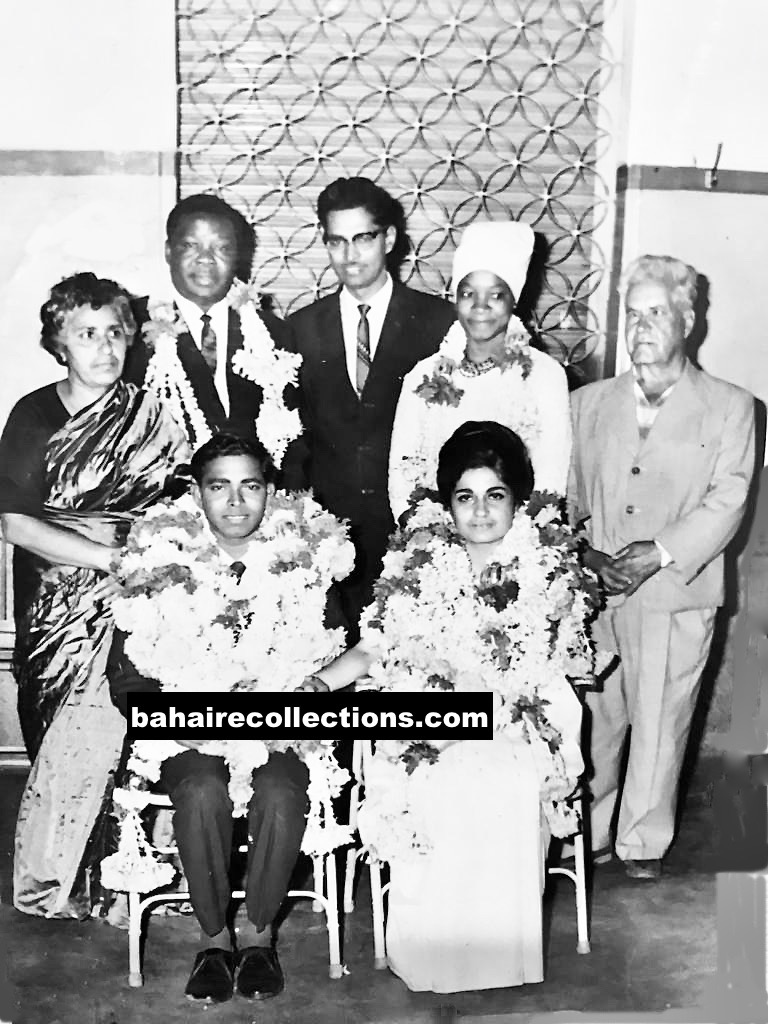
Hand of the Cause of God Mr. Enoch Olinga, Counselor S. Vasudevan and Mrs. Elizabeth Olinga with the couple and the parents of the bride
In 1969, Mr. Kannaiah Adaikkalam from Malaysia joined Saba in Coimbatore city in Tamil Nadu. They, with the support of the Local Spiritual Assembly of Coimbatore, organized a historic Teaching Conference in August 1969. The conference attended by many friends from Mysore, Madras, Salem, Coonoor, and the neighboring Kerala state was graced by the presence Counselor Dr. Vasudevan. The conference received good publicity for the Cause and appreciations from the Supreme Body. The conference took place at a time when the Faith had not emerged out of obscurity in Tamil Nadu. Saba was noted for his individual initiative in teaching the Faith with such an obsession seldom witnessed in those days. As a pioneer, Saba was very motivated, enthusiastic, encouraging, and ready to share the message of Bahá’u’lláh at any time with anybody. Saba made it a point to somehow introduce the Faith to passengers sitting next to him in buses within five minutes of conversation. This gesture was well admired and emulated by several other teachers.
On 8 May 1970 his first child, a daughter Nedah was born in Bangalore, Karnataka. Soon after the birth of Nedah, Saba left with his family to Laos to help with teaching work there. During their stay in the capital city of Vientiane, Saba and Qudsiah helped in the organizing of the filing system in the National office and conducted deepening classes for the friends. It was around October 1970 that Saba brought his wife Qudsiah and daughter Nedah who was five months old to Malaysia to be introduced to his parents at their residence at Bland Road, Seremban, just next to the Anglo Chinese School. Saba’s parents, siblings, relatives, and friends were overjoyed. Of this family reunion, Saba’s younger brother Sethupathi says, “Qudsiah was such a beautiful, kind and a loving person who won over the whole household within a short while. Her cooking was super. More importantly, her attitude and presence projected as if she was the shadow of Abdu’l-Bahá in that house. She was the one who thought me how to say Baha’i prayers.” They then returned to Laos. Saba attended the historical Oceanic Conference held in Singapore in January 1971. There he met Hand of the Cause Enoch Olinga who at once remembered attending his wedding in Bangalore.
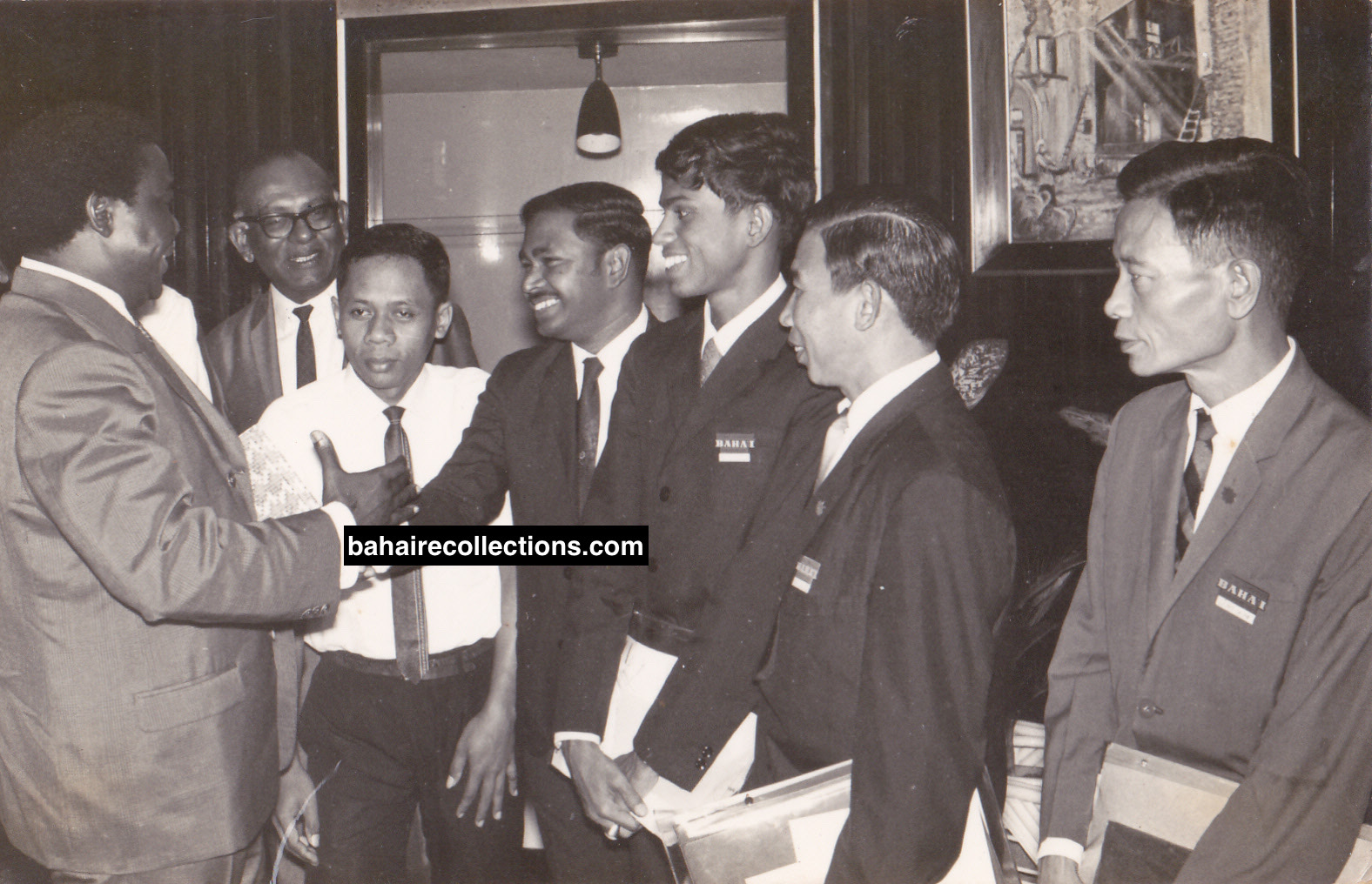
Oceanic Conference, 1971. Saba greets Hand of the Cause of God Mr. Enoch Olinga. Appu Raman is next to Mr. Olinga. Mr. Olinga recollected gracing Saba’s wedding.
After Saba’s second child, a baby boy Nemat was born in Laos on 11 July 1971, they left for India, passing through Malaysia. In India, they stayed in the Bahá’í Centre in Madras (Chennai) city in Tamil Nadu.
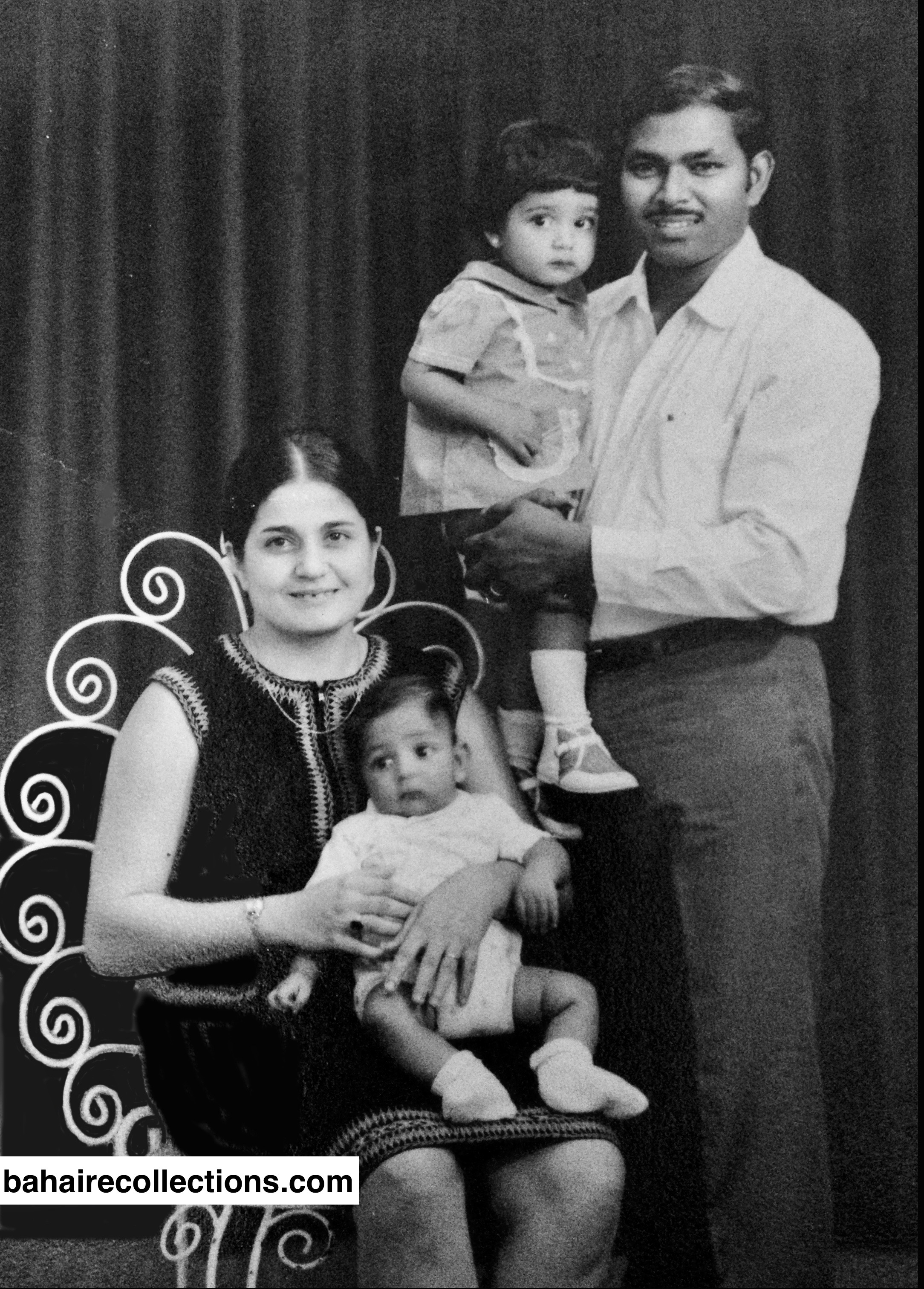
Saba carries Nedah while Qudsiah has Nemat on her lap.
Qudsiah went to the home of her parents in Bangalore to deliver the third child, a baby son Nabil. He was born on 10 October 1972 in Bangalore. Sometime after the birth of Nabil, Saba rented a small house in Madras. Dr. Muhajir had the habit of visiting pioneers that he produced to give them encouragement. During a visit to Tamil Nadu in 1972, Dr. Muhajir saw Saba having three children with very short age differences, and asked him in jest, “Saba, have you heard of family planning?” That brought so much laughter to Saba, Qudsiah and Dr. Muhajir.
The year 1972 was a crucial moment in Tamil Nadu. It was from 1972 that organized teaching came to be introduced in Tamil Nadu, and with that, the Faith was taken to many parts of Tamil Nadu. Saba served as a member of the Local Spiritual Assembly of Madras from 1974 to 1976. Saba concentrated in large cities like Bangalore, Mysore, Madras, and Pondicherry, focusing on college students. One of Saba’s great achievements was teaching the Faith in secondary schools in Mysore state, and giving talks on the Faith over the All India Radio in Pondicherry State.
Life was not easy for Saba in India. With his limited income as a pioneer, he had to make ends meet. Saba enrolled himself into a college to study computer keyboard practice in order to be more marketable in the job market in the private sector. He used to feed his children smashed biscuit in milk for dinner, and the innocent children enjoyed eating that, calling it ice cream. Despite his sufferings, Saba was always pleasant and there was always a calm smile on his face. Qudsiah was his constant companion, shield, and support under all situations, and that brought much consolation to the sincere heart of Saba.
It was during these difficult days that Saba came for a visit to Malaysia in mid-1975. His coming coincided with a Regional Bahá’í Youth Conference held in Seremban in July 1975. Saba was requested to be a speaker at the conference. Saba moved many when he spoke on the topic of “Sacrifice.” He drove home the cardinal message that it has always been the case where the Faith had and would continue to grow only with selfless services and sacrifice. Saba was not a dynamic speaker as any audience would expect. Yet his soft-spoken nature did create penetrating influence in the hearts of the listeners. After the conference, he stayed on in Malaysia for some months.
While in Malaysia in 1975 Saba underwent a period of heedlessness, not knowing what to do next. That was the time when Saba could not secure a sound career in India to sustain his family. Foremost in his mind was the education of his children who were growing up. He was looking for a stable job in Malaysia if that would work, but that was not forthcoming. Basing himself in Seremban, he used to come to the National Bahá’í Centre in Kuala Lumpur often. The National Bahá’í Centre in Kuala Lumpur was the address to which his wife wrote to Saba from India or make telephone calls at a mutually agreed time. Saba would come to the Bahá’í Centre weekly to check for letters and used to sit near the phone waiting for calls from his wife. During those days Saba was very down in spirit. He was fortunate to have an exceedingly kind-hearted friend in Kuala Lumpur- the immortal Inbum Chinniah. On many evenings Saba visited Inbum Chinniah who was an Auxiliary Board Member then at his home for dinner and to get the needed strength to move on with life. After several prayerful attempts to secure a job in Malaysia met with failure, he realized that Bahá’u’lláh must have a reason for closing all doors. Saba then returned to Tamil Nadu.
MOZAMBIQUE – THE FINAL DESTINATION
When Saba was in Tamil Nadu in 1975, Mozambique gained its independence from Portugal. Under the Five-Year Plan, two international pioneers were needed in Mozambique. Mozambique was one of the pioneering goals for India. A call came for pioneers to serve in Mozambique. Saba rose to the occasion and went alone to Mozambique in 1976. There was no assembly when Saba arrived in Maputo. It has to be mentioned that the Cause of Bahá’u’lláh was present in Mozambique since the early 1950s but was not enabled to come out of obscurity owing to domestic situations. But the liberation of the country in 1975 saw the coming of new pioneers. Around the time Saba entered Mozambique, a few other pioneers arrived, and they all played their part effectively. Ms. Charlotte Pinto, an American pioneer was in Mozambique and served as a caretaker of the Bahá’í centre in the later days. With Saba going to Mozambique one of the two pioneering posts was fulfilled. There was still one more post to be fulfilled. When Saba decided to move to Mozambique he contacted Miss Yaw Kam Sim, who was the Manager of the National Bahá’í Bookshop in Malaysia to pioneer to Mozambique. She was hesitant. Saba spoke with Lizet, another Brazilian pioneer in Mozambique to get a job for Yaw Kam Sim. Lizet took up the matter with her boss who was a local Chinese and owner of a big Department Store in Maputo. He offered her a job through Lizet. Saba sent that letter to Yaw Kam Sim in Malaysia. She resigned her job at her school, went home to tell her parents, and prepared for her trip to Mozambique. Saba had been encouraging Yaw Kam Sim to go pioneering from the time he visited Malaysia in 1975. Finally, she joined him in Mozambique. Saba, Lizet, Lizet and Yaw Kam Sim used to eat dinner together as they lived in the same apartment building. Saba occupied the fourth floor which cheaper, all because it was still unfinished. Lizet occupied the third floor while Charlotte occupied the ground floor. By the time Yaw Kam sim arrived Charlotte was preparing to leave the country and so Yaw Kam Sim took over her tenancy. These pioneers were like a big family, eating together, having fun together and taking care of one another. There were not many teaching activities going on. Saba and Yaw Kam Sim were trying to learn Portuguese. It was very unsafe to travel out of the city as there was still sporadic insurgency fighting in the country. Every month the pioneers traveled by bus to Swaziland on a 6 to 8 hours journey to pick up letters and other information from the National Spiritual Assembly of Swaziland. The basic Bahá’í activities these pioneers initiated were the celebration of the Holy Days and the 19-Day Feasts with the Mozambican Bahá’ís from the surrounding villages. They rented a house for those activities. Things got worse after the country became independent. There was a complete shut down of the Bahá’í activities for some time. A Portuguese pioneer with his wife and two young children went back home. The company Yaw Kam Sim worked for was sold off and moved out to Portugal. Lizet moved with them to Portugal. Yaw Kam Sim stayed in Mozambique for a little over a year and then left for Vermont to marry Mathews Wagner. They are now settled in New Mexico, USA. Saba rented a house and was applying for his family to come over.
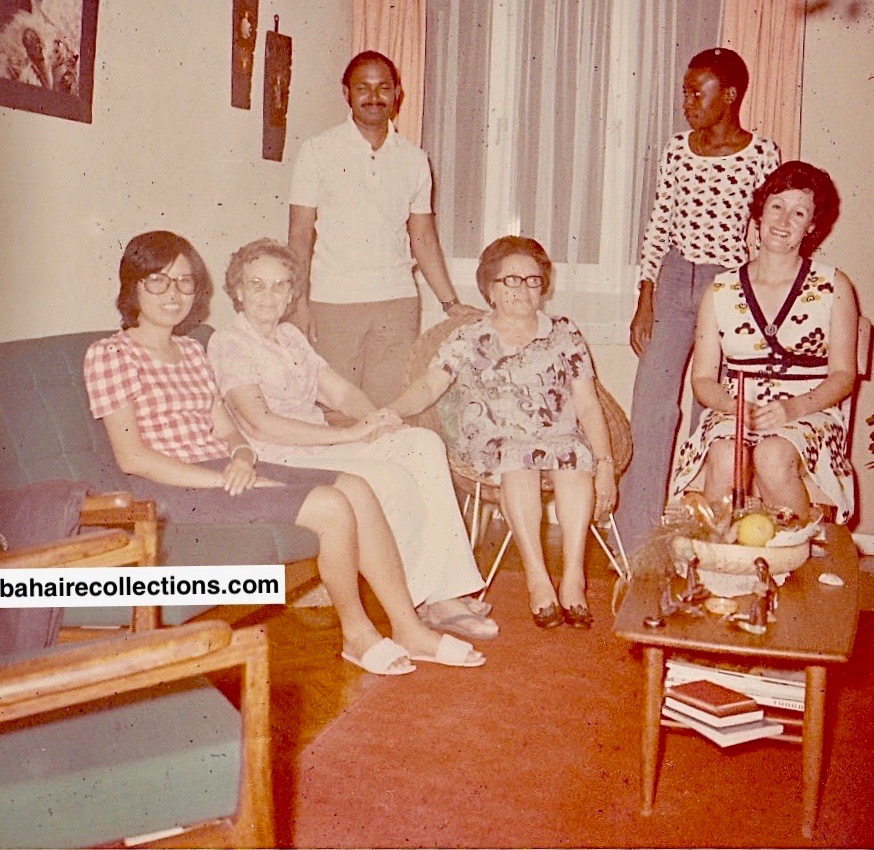
Cheering each other, 1977. L-R: Yaw Kam Sim, Charlotte Pinto and Saba with other friends.
It did not take long before Saba realized that the opportunities to serve in Mozambique were plenty. He saw a new door- a bigger one had opened for him in that country. Wisdom dawned upon him as to why his arduous efforts to stay on in Malaysia did not work out. He first worked for the Railways Department in 1976 and then in the Agriculture Department from 1985, in his own specialist field of telecommunications. While in the Ministry of Agriculture he served under the Mozambique- Nordic Agricultural Program (MONAP) that took him to Norway where he sat for an examination and emerged full-fledged Engineer. This position enabled him to travel to different states in Mozambique to set up communication links. He used this opportunity to teach the Faith and set up Local Spiritual Assemblies in different communities. While in the capital city of Maputo Saba visited the National Bahá’í Centre daily to provide assistance in cleaning the Centre. His commitment to maintaining a very simple, clean and dignified Bahá’í Centre reflected a very high level of commitment and dedication of this truly responsible servant of the Faith. Saba soon picked up the local language and was at one with the masses. With this added language he moved even closer with them.
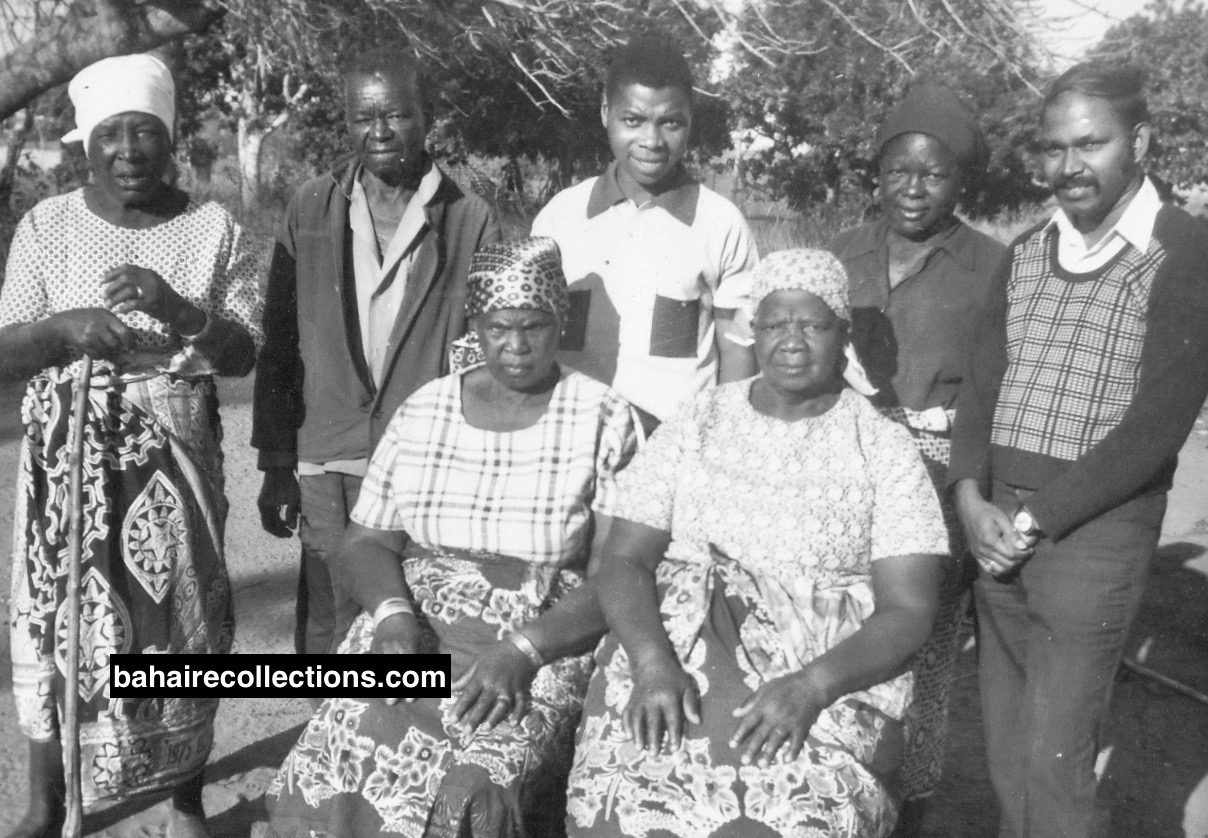
With the local believers
When Qudsiah and her three children joined Saba in 1978, they started to live in a neighborhood where they were the only foreigners and the rest were locals. Yet it did not take long before they made friends with the local community and gained their trust and respect. They were loved and respected by the believers and non-believers alike. In the beginning, Saba did not have a car. The family had to walk to the Bahá’í centre every Sunday for prayers and devotional meetings. After some time Saba got a small jeep which for all intents and purposes was used for the Faith. The jeep took them to several places. One of the first African Bahá’ís in Maputo, Mr. Papa Duna built a Bahá’í centre on his land and donated it to the Faith.
Life in Mozambique was not a bed of roses either. It has to be noted that while Mozambique gained its independence in 1975, the country was still plagued by a long and violent civil war from 1977 to 1992. During this period each family was given a ration card, and every month they were only allowed a limited amount of rice, oil, flour, and sugar. Availability of these at the shops was not a guarantee either. Eating meat was a luxury during those days, and the availability of meat was also not a guarantee. Every morning someone had to stand in a long queue to get bread for breakfast, which too was not a guarantee. Coupled with this there was a scarcity of electricity and water supply. There were long periods when there was no water, and people had to go to certain zones to fill drums with water for cooking and washing clothes. Saba toiled with patience in all his sufferings and was pushed to the hardest living conditions. At one time Saba and his family were forced to live a very simple life in a small house, at the most time denied basic necessities and conveniences of life. Yet he never hesitated to give up everything he had to provide the best hospitality to visitors to the extent of depriving himself and his family of even the basic comforts. The Supreme Body knew the predicament of Saba and was gracefully given a choice to leave Mozambique if he wanted. But the relentless Saba stayed on, impelled by the excessive love he had for the advancement of the Faith in that country. Although the difficulties were arduous, Saba was able to bear every suffering and ordeal with unflinching strength and absolute faith in his Creator.
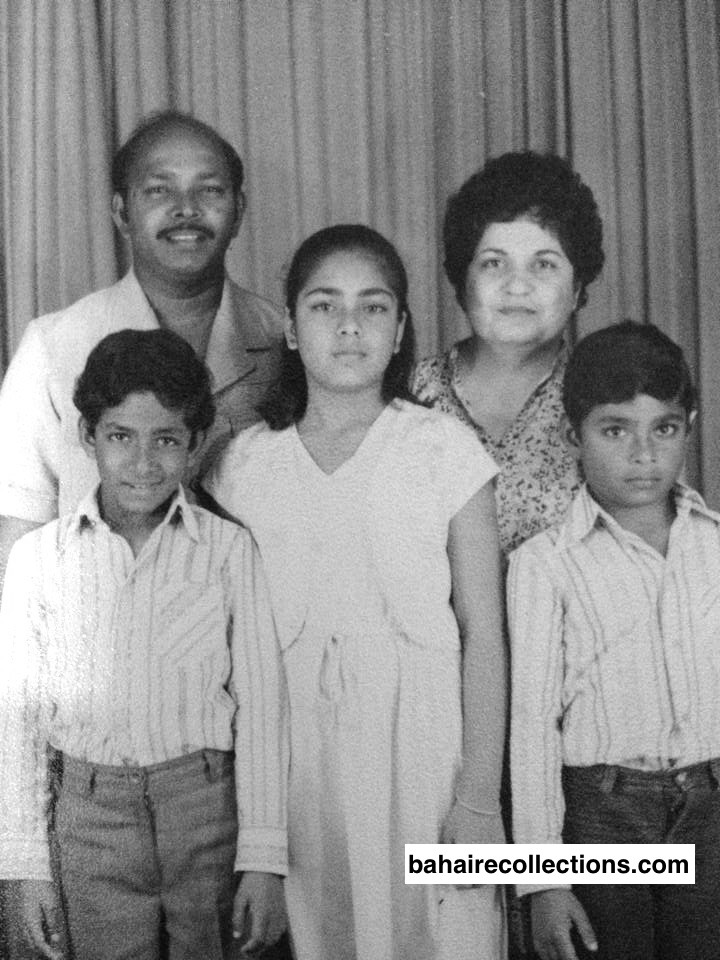
Summer Camp in Swaziland. L-R: Nemat, Nedah, and Nabil.
Under all these stress and strains, Saba soldiered on in serving the Faith. Taking the Faith to the villages was uppermost in the mind of Saba. Every weekend he used to drive with his family to remote villages to meet the Bahá’ís, despite great risks posed by the rebels. One miscalculated move could have landed his family in greatest of perils. On many occasions, the local military that was guarding checkpoints had advised him against going beyond certain border points, but Saba felt that with his life in the hands of Bahá’u’lláh, nothing could easily imperil his safety. On some occasions, the military guards would escort him with a convoy until Saba reached a safe zone. At times Saba would drive on, and at other times the family would walk for miles, depending on the approach roads. Qudsiah cooked and packed biryani rice on their family teaching trips to the villages. The risk they took and the persistence with which they journeyed into those villages always paid off handsomely. When they reached the villages by jeep the children would run next to the car shouting “Allah-u-Abhá.” Most of the times the family visited a few villages in a row and return in the wee hours of the night. In Matola Rio, one of the Bahá’ís donated a piece of land to be used to build a Bahá’í centre. Saba’s family took upon themselves to build the centre painstakingly, with the help of the local Bahá’ís, and with very limited funds. Saba’s three children carried bricks in their car for the construction works. Among other places, the family visited Costa de Sol, Boane, Namahasha (border town next to Swaziland) and Infulane.
The beginning of 1981 was a distressing period for the family. Qudsiah suddenly fell sick and had to go to India to have a scan done. It was discovered that she had a pituitary tumor and the only option was surgery. She went to Kanpur and received treatment by Dr. H. M. Munje, the famous Homeopathy doctor, and a great scholar well versed in Hinduism. After two years another scan was done and there was no sign of any tumor! During the time Qudsiah was under treatment she also gained knowledge on homeopathy from Dr. Munje. While Qudsiah was in India, the three children were sent to study in the famous New Era High School in Panchgani from 1981 to 1982. In these two years, Saba had to be all alone. With Qudsiah having fully recovered, she and her two children returned to Mozambique and joined Saba.
FEW MORE CO-WORKERS
Two other prominent believers from India pioneered to Mozambique. Saba and Qudsiah were instrumental in Mr. B.S. Prabhu pioneering to Mozambique. They arranged his visa and travel arrangements. When Prabhu arrived in Maputo in June 1982, he stayed with Saba. Saba spoke to Sr Dinis, a Director in the Mozambique Railways and secured a job for Prabhu in Anfrena, where he worked for 5 years as internal auditor. This experience enabled him to set up his own accounting practice and tax consultancy. He had served as Auxilary Board Member and on the National Spiritual Assembly. He is today rooted in Mozambique. Likewise, each time Saba visited India from Mozambique he had encouraged Mr. Sankararaman Krishnamurthy of Tamil Nadu to pioneer to Mozambique. Through the efforts of the Continental Pioneering Committee of Africa, Sankararaman pioneered to Mozambique, with Saba facilitating visa for him. Sankararaman arrived in May 1982 and secured employment as a Textile Engineer. Sankararaman had served as Auxiliary Board Member. He had to return to India in 1990 owing to the health problem of his children.
In 1985 the believers in Mozambique saw the dawn of a new day with the election of its first National Spiritual Assembly. Saba was serving on the Administrative Committee of Mozambique. He was also an Auxiliary Board Member from the early 1980s and therefore wished not to be elected onto this first National Spiritual Assembly. Qudsiah was elected along with Prabhu on this first National Spiritual Assembly. In later years Qudsiah and Saba were both elected onto this august institution and attended international conventions.
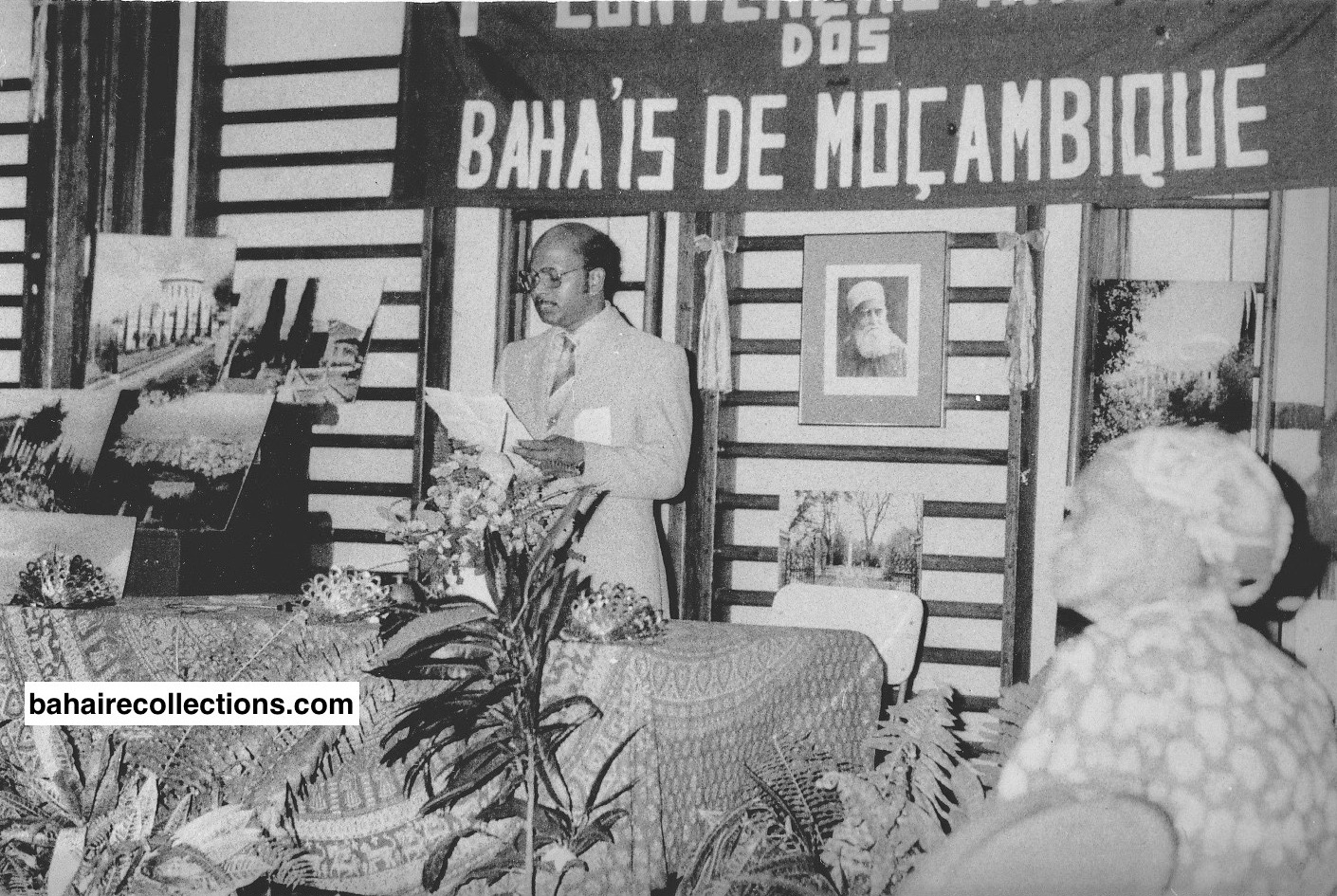
Auxiliary Board member Saba addressing at the first National Convention.
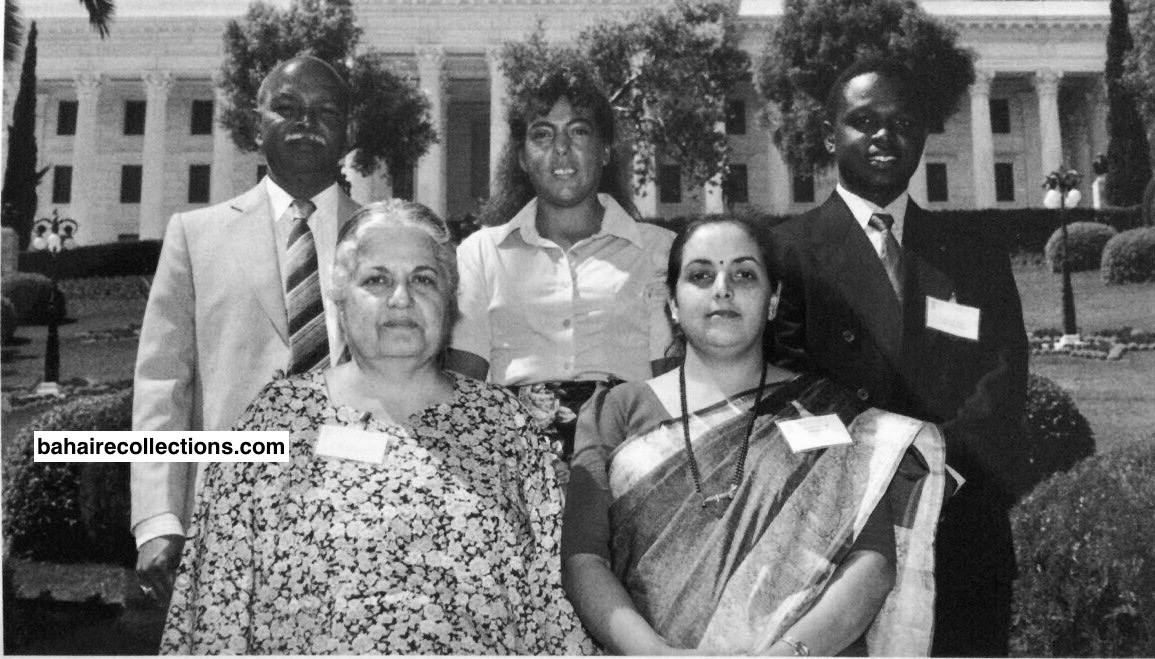
Eighth International Convention. Back row L-R: Saba, Jandira R. Lima, and Hugo R. Raja. Front row L-R: Qudsiah and Mrs. Bharathi Prabhu.
WIDENING THE CONTACTS
Teaching the Faith in Mozambique was not always easy. The domestic environment did not allow full freedom for the propagation of any religion. The believers took cognizance of the Master’s advice that under all conditions the Message must be delivered. When Saba and Qudsiah found that direct teaching method was not that easy, they decided to get involved in the Non-Governmental Organizations that were aligned with the spirit of the teachings and also involved in inter-religious activities. The couple registered unprecedented success in this effort, as they managed to make the Bahá’í Faith known in every nook and corner of Mozambique.
Saba was instrumental in bringing all the religions together in Mozambique when he formed the Religious Council of Mozambique (COREM) and served as its President for several years, representing the Bahá’í Faith. Saba also helped initiate the World Religion Day celebrations in Mozambique which still goes on every year.
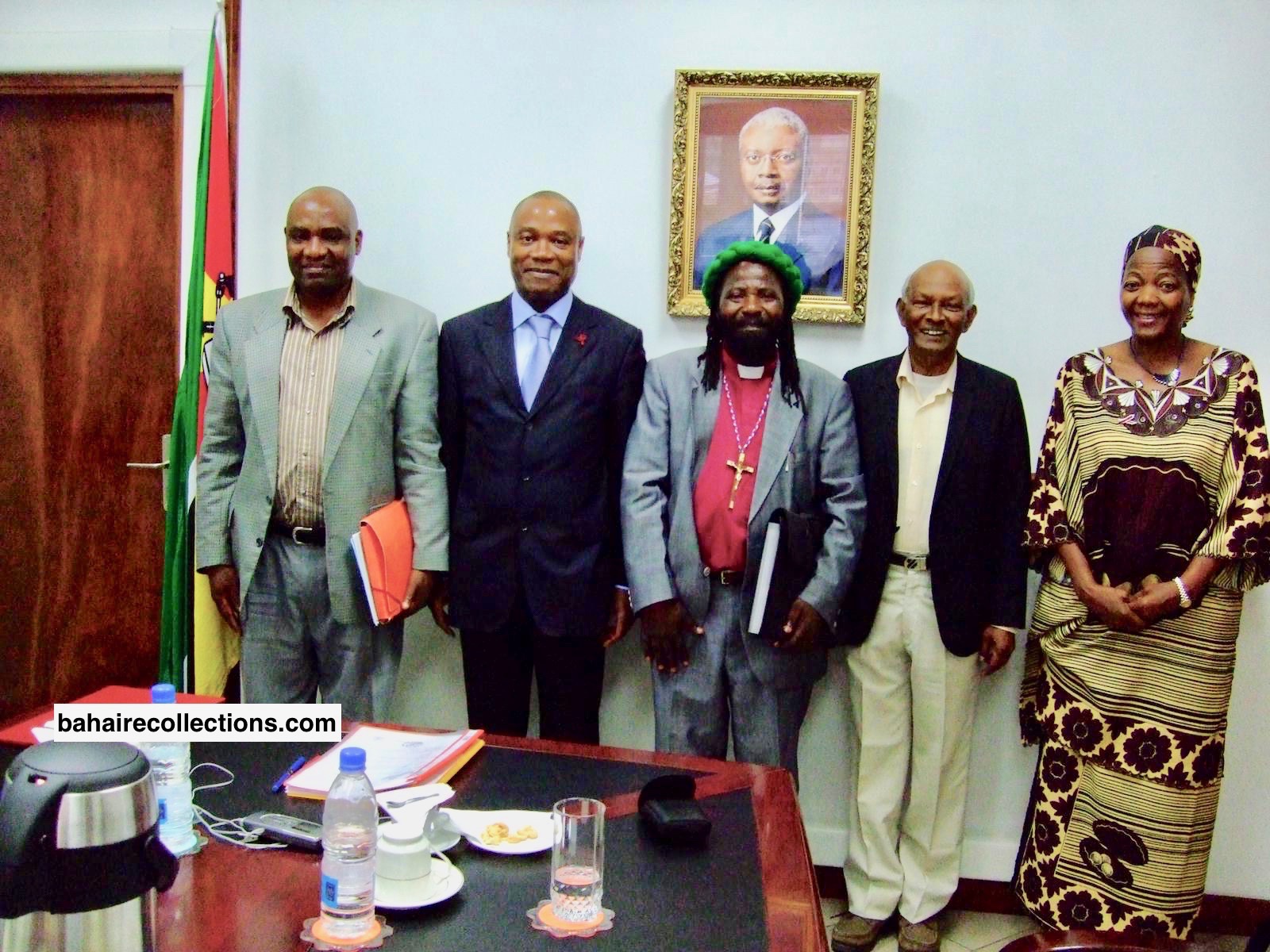
Religious Council of Mozambique (COREM)
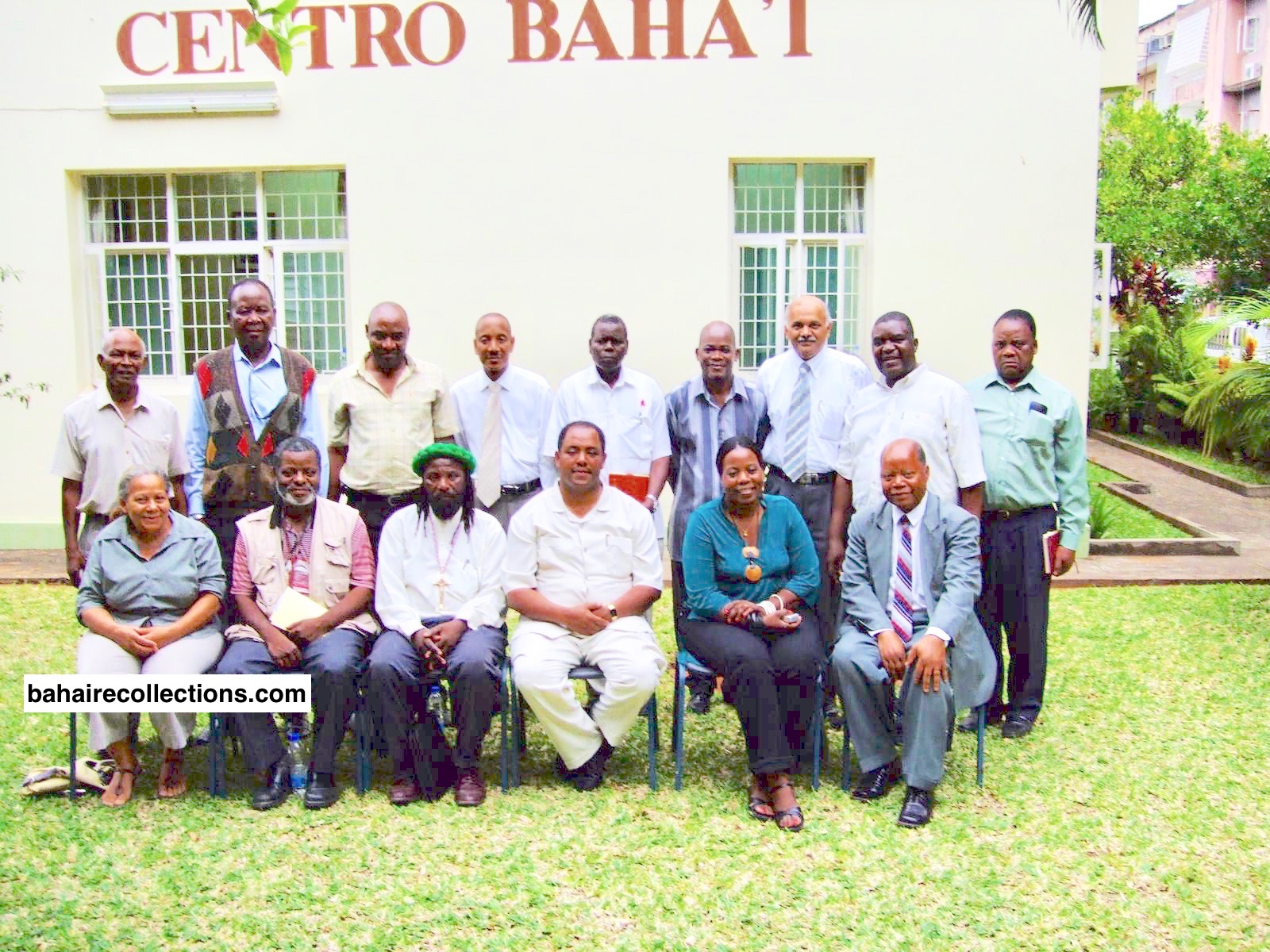
The celebration of World Religion Day at the Bahá’í Centre of Maputo, 2003. Saba stands at extreme left and Prabhu stands third from right.
Though limited in his financial resources, Saba on his own initiative completed two classrooms for a school in a rural area. He and his wife formed a Non-Governmental Organization and secured some funds for education for women, and they ran several projects for women in various villages from stitching to pottery classes.
Qudsiah played a pivotal role in the education of underprivileged children. She became the founder of Escola Ntwananu, a non-profit organization that promoted free education for underprivileged children and developed programs to empower rural women. Qudsiah often visited nearby villages on the outskirts of Maputo accompanied by Saba to help the poor and the needy. During their visits they saw many rural children unable to go to school, owing to lack of means. Qudsiah herself did not have sufficient money to educate them or build a school for them. In 1995 she started her first free educational class for the children of the village under the shade of a big tree. Several dignitaries heard of this successful and visited the school.

Wife of the Chinese Ambassador standing next to Saba, and another official visiting the school.
Over a period of time, through her relentless efforts and donations received from friends that the small class operating under the shade of a tree developed into a fully functional primary and secondary school, attracting more than 1,000 students. Some of the students who studied under the tree grew to serve as teachers in the schools. At the time of writing this story, there were some 400 students getting formal education and another 50 adults undergoing adult literacy at the Escola Ntwananu. Saba’s daughter Nedah is the Vice Director of this school. The Faith is so closely associated with the school that the local people call this “Bahá’u’lláh School”.
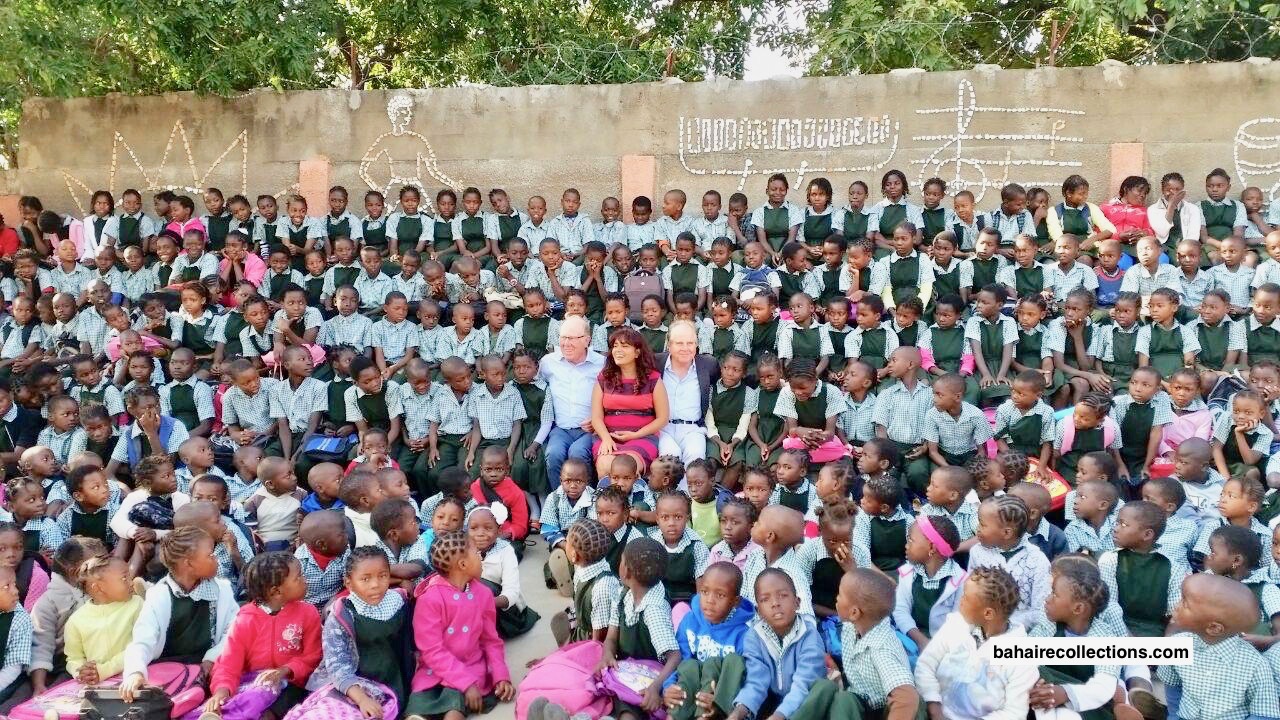
Students at Escola Ntwananu. Seated in the centre is Nedah, Vice Director of the school
Qudsiah also set up the Association of Alternative Medicine in Mozambique with their house as a centre. The main purpose was to serve the sick who could not afford to go to the hospitals as it was very expensive and to serve people in the rural areas where hospitals did not exist. Qudsiah herself took a course on traditional medicine, and she was also a Homeopathic practitioner with training provided by Dr. Munje in 1981 and 1982 in Kanpur. She soon became known to many as “Dr. Saba”. This Association was registered with the government in 2004 and hundreds used to come for healing and treatment. Treatment was free of cost, there was a container if anyone wanted to donate. Soon people from all walks of life and all strata of society flocked to her house for treatment. The house became a self-teaching centre with the display of the photo of the Master and the Greatest Name on the walls, and the availability of Bahá’í literature all over. The patients knew from whose hands they were getting treatment and prescriptions- from a Bahá’í.
Saba was the Public Relations Officer of the Bahá’í Faith in Mozambique and developed a very close relationship with the Government authorities. He was the Regional Coordinator of United Religious Initiative (URI) that was set up in 1995 in San Francisco to commemorate the 50th anniversary of the United Nations. The vision of URI was to create an initiative whereby people of diverse Faiths could work daily for peace. More than a million people in more than sixty countries have participated in URI activities since its inception. Saba was elected to the URI Global Council in 2002, served as the Regional Coordinator for South East African Affairs for the URI for a number of years and was also the trustee of URI for Mozambique. With these positions, Saba organized several activities, which came to be well appreciated. One of the landmark events was the Awareness event organized in 2008 to mark the International Day of Peace Vigil for the year. Through his involvement in URI, Saba traveled for its activities in various parts of Mozambique as well as countries like India, USA, Egypt, and Swaziland promoting the tenets of the Faith.
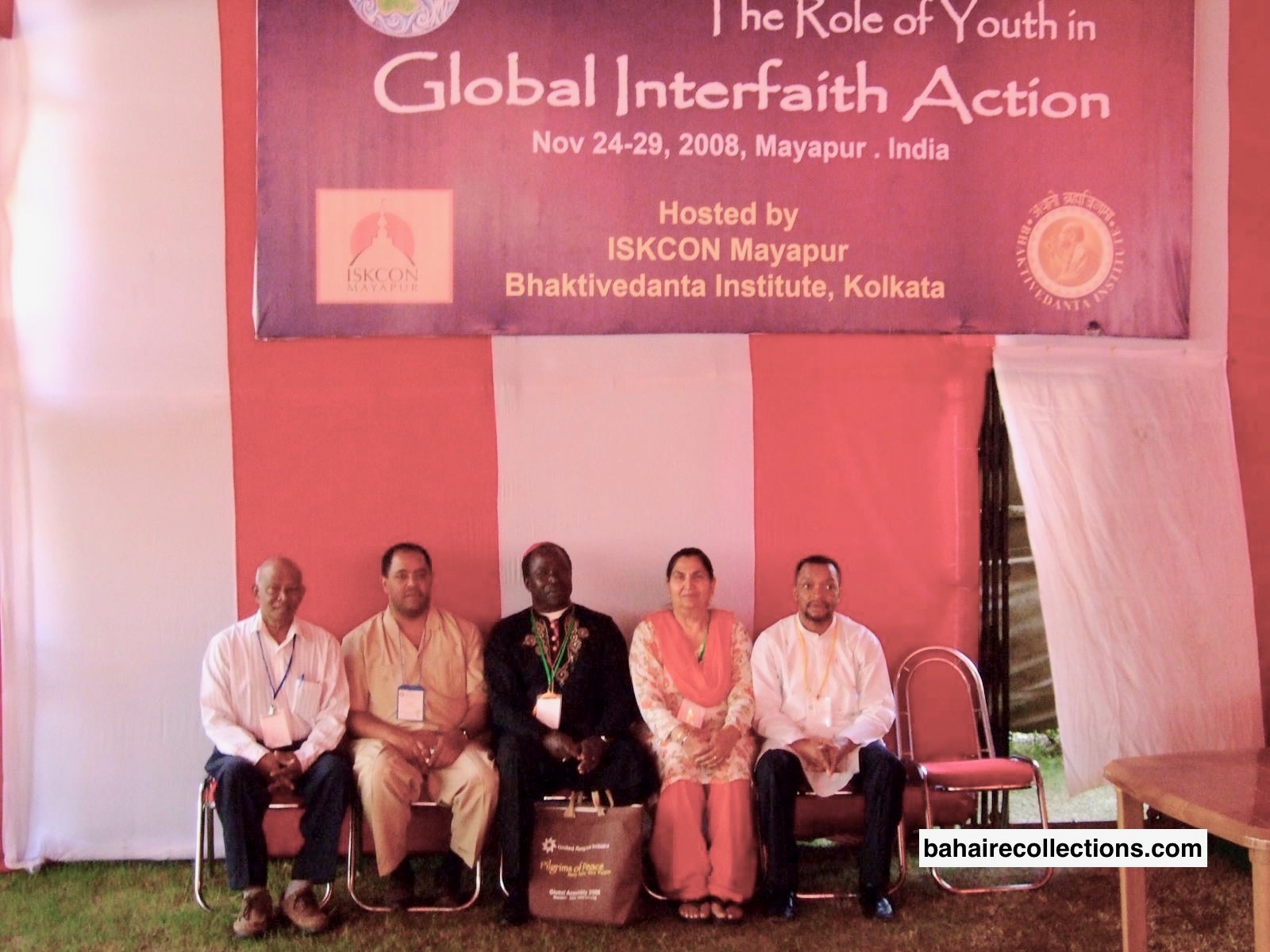 Global Interfaith Action, Calcutta, India
Global Interfaith Action, Calcutta, India
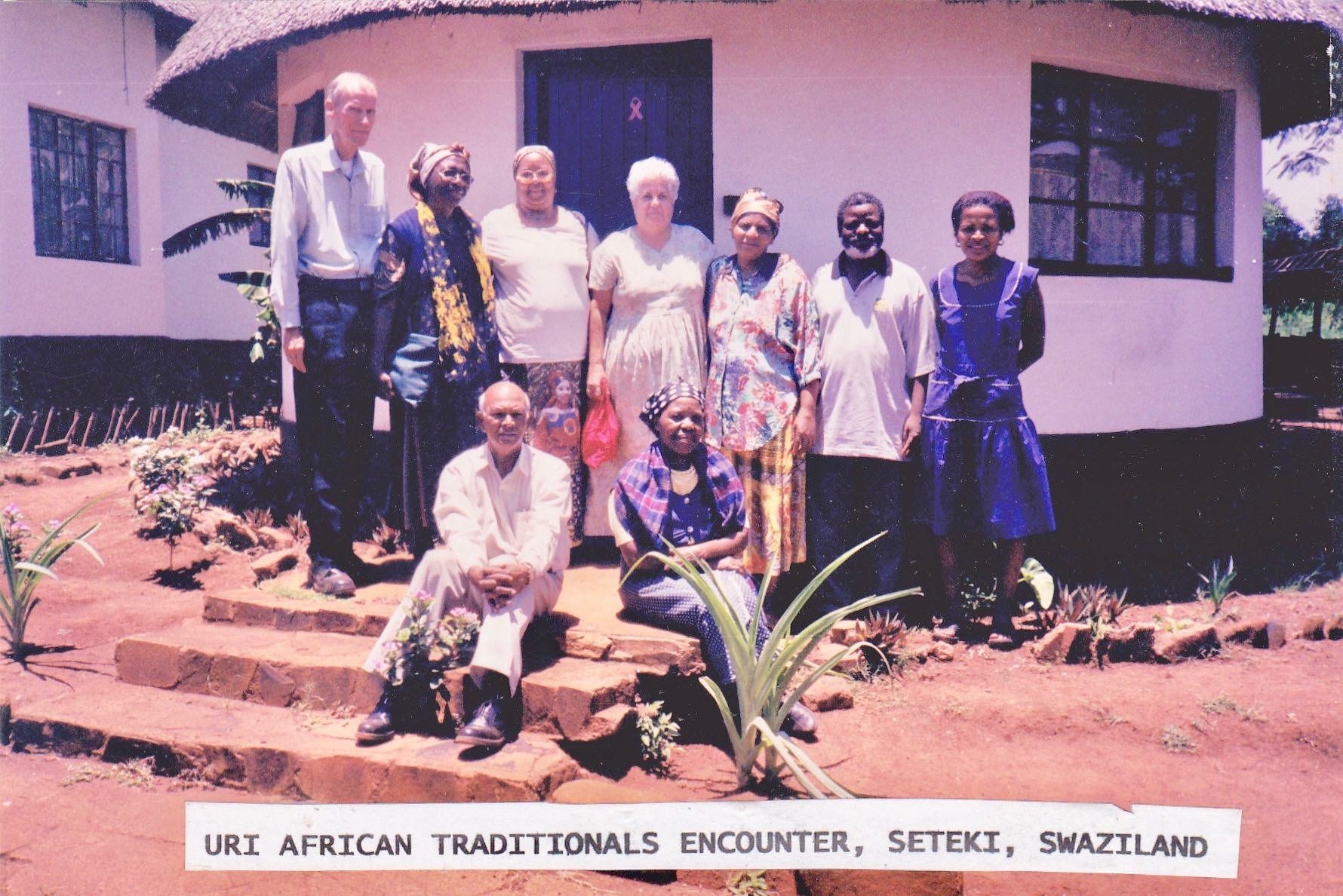
URI African Traditionals Encounter in Swaziland with Qudsiah
Saba was also an active member of the Global Family for Love and Peace (GFLP), a body that was affiliated with the United Nations Department of Public Information and worked in consultative status with the United Nations Economic and Social Council(UNESCO). Saba organized dawn prayer session at the Bahá’i Centre and the program included prayers and meditation, discussion and readings from the Holy Scriptures and singing songs for Peace. Saba was also the Trustee of the Interfaith Cooperation for Peace, Justice, and Healing for Mozambique in 2005.
Yet one more organization in which Saba was active was the Inter-Religious Campaign against Malaria in Mozambique (IRCMM). This body had representatives from the Roman Catholic Church, Hindu community, United Methodist Church, the Christian Council, Islamic Council of Mozambique, Islamic Congress of Mozambique, Anglican Church, Assemblies of God, and the Seventh-day Adventist Church, with Saba representing the Bahá’í community.
His unique and active involvement in the area of External Relations in Mozambique was undoubtedly unparalleled and unprecedented. He was highly respected in government circles, and well received in public places. During the 50th anniversary of the establishment of the Faith in Mozambique, Saba was one of those who was highly mentioned for his sacrifices for the establishment of the Faith in that country. The couple won numerous sympathizers for the Cause.
LAST DAYS
From the year 1976 when Saba entered Mozambique all his energy and time were devoted to the growth of the Cause. It took the toll on his health. Saba was a diabetic patient for quite some time. As early as 1991 Saba fell seriously ill due to his diabetic condition and landed up in the Intensive Care Unit in Maputo Central Hospital. The doctors gave up hope as all his vital signs were failing. That was the time when both Nemat and Nabil were studying in Malaysia. Qudsiah called Satanam in Malaysia to get his sons to fly back to Mozambique. Satanam relayed this urgent message to them. Meanwhile, Qudsiah gave Saba some homeopathic medication and prayed, and Saba miraculously recovered. Saba was back in action in serving the Cause, though still suffering from some ailments. In 2005, Saba had heart surgery and was feeble then onwards.
The passing of Satanam in 2005 dealt a heavy blow to Saba. Saba was in Sydney when he heard of the passing of Satanam in Malaysia. He quietly moved into a room and spent much time praying in privacy.
Saba made his last trip to Malaysia in 2008 to meet his families and friends. Each time Saba went to Malaysia, he visited his family and his close friends, especially Satanam. He also visited the resting place of his parents to offer prayers. When Saba went to Malaysia in 2008, his health was already failing drastically, and he had wanted to see as many friends and relatives as possible in what he considered the very last trip. Sad to relate, he could not visit some of those he was keen on visiting for the last time.
Our Malaysian pioneer to Africa, Kamachee and her husband Pierre pioneered to Mozambique from September 1995 to January 1999, after which they moved to Lesotho. Kamachee recalls Saba performing his Malaysian/Thai “joget” dance at a Naw-Rúz feast in Maputo Bahá’í Centre. She passed through Maputo in 2009 and saw that Saba was not keeping well at all. Despite the turmoil that comes as part of a package for most pioneers, Saba pulled up his guts and managed to maintain his spirit. That was the last time Kamachee saw him. Saba had given the Faith to Kamachee’s elder brother back in Seremban.
In 2009, he developed kidney ailment that led him to receive dialysis as an outpatient. As his condition deteriorated, Qudsiah called Nabil who was in Australia to rush over to Mozambique to assist in looking after Saba. Nabil returned as requested, and looked after Saba as a dutiful son, bathing him, cooking for him and taking him to several gatherings in the last few months. Nedah herself was 7 months pregnant with her last son Yasheen, but that did not stop her from taking Saba to the hospital every other day for kidney dialysis. Qudsiah on her part was serving Saba as a loving wife and resorted to ardent prayers. Nemat was the only one outside Mozambique. Suddenly Saba’s kidneys were failing badly, and he had to be admitted in the Intensive Care Unit of the Central Hospital of Maputo. While undergoing dialysis, Saba slipped into a coma. But a few days later he recovered and was fully conscious of the surroundings. On 29 August 2009 Nemat who was in Australia learned of his father’s condition and telephoned the doctor in charge, his mother and father. The doctor assured Nemat that Saba was recovering fast and that he would be discharged the following day, while Qudsiah said Saba was miraculously doing well. When Nemat spoke to Saba, he urged Nemat to serve the Faith with all his energy. Saba’s parting words were that he and Qudsiah had done their best for their three children and that they were now old enough to look after themselves. Although Nemat’s phone conversation gave good hopes, he somehow had an inner urge to fly down to Mozambique, and that too immediately! He informed Saba that he was starting off at once, and made arrangements to reach Mozambique by the earliest flight. Sadly Saba once again went into a coma after the phone conversation with Nemat on the evening of 29 August 2009. Visitors were strictly not allowed. But Nedah managed to smuggle herself into the ICU and spent some time praying for her father. As she kissed her father good bye, she observed tears rolling down his cheeks. She then left, though reluctantly and with tearful eyes and a heavy heart. On Sunday 30 August 2009 at 5:00 am, Saba had a heart attack and his pure soul ascended to the Abhá Kingdom. None of the family members were near him at the time of his passing. The passing of Saba was immediately relayed throughout the country. The Supreme Body, several National Spiritual Assemblies, and several Non-Government Organizations were informed. Nemat arrived at the Maputo airport on the afternoon of the day Saba passed away, and Nabil received him. Nabil remained silent all along, and Nemat guessed it correct. When pressed, Nabil broke the sad news that Saba had passed onto the Realms of the Unseen that morning. Saba’s sister Leela, brother Ratnam and nephew Kannan flew down from Malaysia on time to attend the funeral.
The funeral service started at 1:00 pm on Thursday, 2 September 2009, attended by some 200 Bahá’ís and non-Bahá’ís comprising Jews, Christians, Muslims, Agha Khans, and the traditional healers. The hall was packed to capacity. Everyone spoke highly of Saba and praised his virtues. Messages of condolences from various individuals and institutions from near and far poured in. The messages were read along with messages from the Local Spiritual Assembly of Maputo and that from the National Spiritual Assembly of the Bahá’ís of Malaysia. There was a special message from the Universal House of Justice expressing sadness, and at the same time assuring prayers at the Holy Shrines for the progress of his soul. Messages from leaders of other religions with whom Saba had associated carried words of accolades on this dedicated servant of Bahá’u’lláh. It was indeed a funeral of a rare kind in the history of the Faith in Mozambique. And true to what he preached, his bones are today permanently buried in the pioneering field. Though he faced untold trials and tribulations in several of the countries where he served, never for once did he intend to return to his homeland.
HIS LEGACY
Saba leaves three married children-a daughter, Nedah residing in Maputo, and two sons Nemat and Nabil, residing and working in Sydney. Through his three children, Saba left behind nine grandchildren. His three children were born in the pioneering field and shared the same hardship that their parents underwent. Saba’s beloved wife Qudsiah herself passed away on Sunday, 11 April 2014 near Maputo, following a period of illness. While still alive the social services of the couple became a household name in Mozambique and were well acknowledged by the government authorities. Despite the manifold challenges and tests the couple faced, they observed tenacious allegiance to the tenets of the Faith and died firm in the covenant.
He was a very humble servant with an upright character, who always consulted Bahá’í books for guidance in his life. He believed in practicing what he himself preached. His constant counsel to the youths of Malaysia was to memorize the writings of the Faith, live a spotless life, and avoid smoking in order to be effective in the Cause. Saba himself was inflexibly opposed to compromising the teachings of the Faith for whatever reason.
Saba loved the company of Bahá’ís and never missed Bahá’í conferences and gatherings wherever they were held. Saba’s love for the Blessed Beauty was so strong that he often spoke of how Bahá’ís could make Bahá’u’lláh happy by picking an area of service and do the utmost to excel in that field. Saba, throughout his life, loathed backbiting. He would either discourage backbiting or avoid the company of those who were involved in backbiting. His respect and reverence for the elders, in the Faith, was something that his close associates always admired. He was seen as a shy person who avoided stage and crowd but never failed to rise up as a giant in defense of the Faith. He had a high sense of humor and shared his highly witty jokes only among close friends. One of his greatest assets was his radiant and warm smile. People enjoyed his company for the sincere and warm love that he radiated.
Saba’s name and his devoted services are eternally engraved in the history of the Faith in Malaysia, Thailand, Laos, India, and Mozambique. Saba has set an exemplary life that deserves to be emulated by the current generation and generations yet to be born.
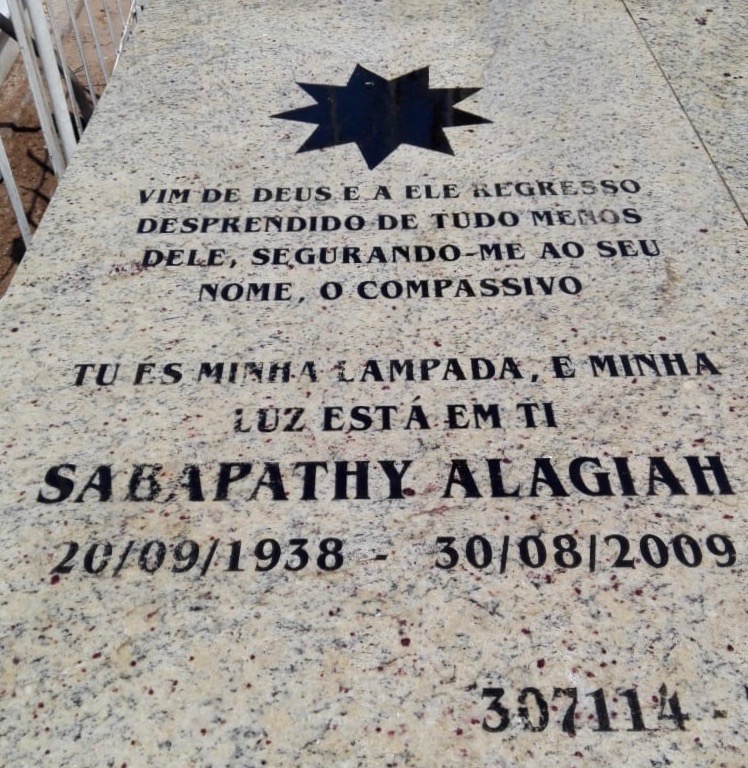
Saba’s final resting place
The Guardian is well aware of the great sacrifices required of the devoted pioneers, and of the problems, they must meet and conquer. This is why he feels that the work of the pioneers is the most important Bahá’í task any individual can perform today—more important than serving on a National Assembly, or any administrative post. While it carries great responsibilities; and difficulties; yet its spiritual blessings are so great, they overshadow everything else; and the opportunities for special victories of the Faith so abundant; the soul who once tastes the elixir of pioneering service, seldom will do anything else.
(Shoghi Effendi, Lights of Guidance, p. 578)
A. Manisegaran
31 December, 2018
Copyright©bahairecollections.com